The data captured, created, copied, and consumed was around 64.2 zettabytes in 2020. About 80 zettabytes of data are expected to be created by 2023. It, therefore, is no surprise that organizations today find it hard to manage and store all these large volumes of data.
The storage capacity is expanding at a compound annual growth rate of 19.2% between 2020 and 2025.
Thus, companies need mechanisms to save and retain all this data today. Data warehouses play a major role in this regard. This article will explain data warehouses’ various aspects, including their definition, types, stages, tools, and more. Let’s start with the definition.
Download Our Latest Industry Report for FREE: Data Science Skills Survey Report 2024
What is a Data Warehouse?
Data warehousing in DBMS is crucial for organizations today. It allows businesses to generate meaningful insights from the large volumes of data available. It also plays a crucial role in the data management process, enabling the easy storage and analysis of large volumes of data.
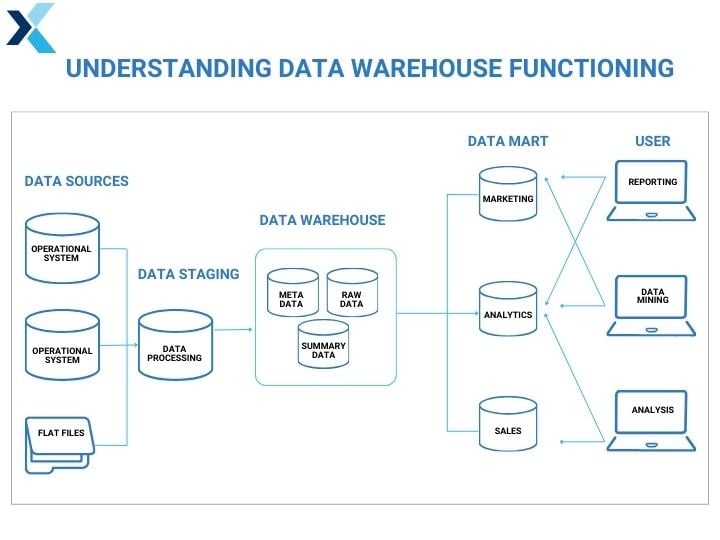
Let’s understand what a data warehouse (DWH) is.
Preparing for the data warehouse interview, check out our latest article on Data Warehouse Interview: Top 30 Questions and Answers [2024 edition]-
Definition
Data warehousing is the process of developing, managing, storing, and securing data in a digital warehouse (DWH). In a DWH, the data is stored in a specific structured way, allowing businesses to use it for numerous purposes, such as data analytics and model building.
Unlike other software commonly used in data science that allows users to perform analytical operations, data warehouses cannot analyze data alone. Instead, they rely on data analysis and querying tools like SQL.
One must remember that a data warehouse is a data storage resource and is different from its peers, such as data lakes because it has a well-defined structure and organization. Still, numerous ways and strategies exist for creating a data warehouse (which will be discussed later).
-
Types of Data
The focus of any data warehouse is to hold data to find useful insights at any point in time to help the business make better decisions. A data warehouse allows data to be stored for a long period, and the data can be historical and act like a library of historical information.
A data warehouse allows the user to update information to this historical data by moving new data to it. This is why data warehouses can often hold data that varies in age. It is common for a data warehouse to include data generated in near real-time and have data from a week, month, or even years back.
Let’s understand this data warehouse concept with an example. Suppose you work in an organization that has a data warehouse. In that case, you will encounter various stored data, such as business transaction data, logs from operating systems and applications, network traffic, authorization requests, user authentication, CI/CD operations, etc.
-
Purpose
To answer the question of what a data warehouse is, you need to understand its purpose. The primary purpose of a data warehouse is to provide users with a central repository of information that can be used for querying and analysis. As data from relatively large periods is available in a data warehouse, it allows users to understand trends and patterns over time and answer various kinds of questions, such as
- Which products generated the most revenue this month?
- Which products drive the highest volume of sales?
- What happens on the network when a particular application experiences a slowdown in performance?
- Which applications have the lowest availability?
A data warehouse isn’t merely for archiving data; it enables users to compare historical and recent data, providing a holistic view for analysis. For instance, while a data archive may overwrite old information, a data warehouse stores data for longer periods, facilitating comparisons across different time frames. This allows users to gain insights and understand organizational events comprehensively.
-
Key Characteristics
You can further understand a data warehouse by going through its key characteristics. These include:
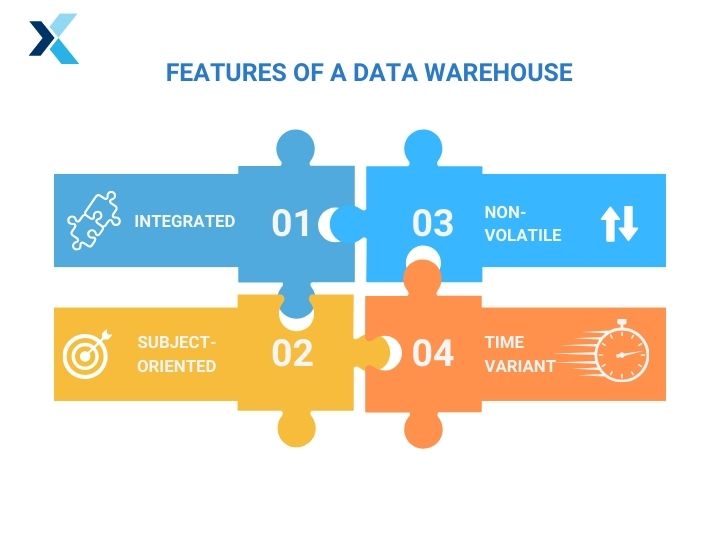
1) Subject Oriented
Data warehouse provides topics rather than overall information on the various business processes. These topics can be sales, marketing, inventory, etc. Let’s take an example of the data warehouse.
Suppose you, as an organization, intend to analyze your sales. In that case, you will create a data warehouse that focuses on holding data related to sales so that questions like “Who are the top 5 spending customers?” can be answered. Thus, the data is subject-oriented in data warehouses.
2) Integrated and Consistent
As mentioned earlier, a data warehouse is a repository that follows a particular structure. Hence, data within a data warehouse is standardized into a uniform format across diverse sources. This ensures consistency in the warehouse’s naming, coding, and formatting, promoting universal acceptance and seamless integration. This eases the downstream applications like data analytics and predictive modeling.
3) Non-Volatile
All data in a data warehouse is read-only and remains unchanged once it enters the warehouse. The warehouse’s capacity needs to be maintained, as the old is not erased upon the arrival of new data. This characteristic of a data warehouse allows users to understand what happened and when.
4) Time Variant
A data warehouse (DWH) facilitates trend analysis by storing data with a temporal component. Usually, data includes a primary key with a time element (e.g., day, week, month), or time-related documentation, whether explicit or implicit, for comprehensive temporal analysis.
Now, if the definition of data warehouse is clear, let’s explore how data warehouses work, but first, a short note-
Explore our signature data science courses and join us for experiential learning that will transform your career. We have elaborate courses on AI, ML engineering, and business analytics. Choose a learning module that fits your needs—classroom, online, or blended eLearning. Check out our upcoming batches or book a free demo with us. Also, check out our exclusive enrollment offers
Understand the Workings of Data Warehousing
A data warehouse (DWH) collects data from diverse sources, often relational, and transforms it into a multidimensional schema for analysis in business intelligence tools.
The data may be in structured, semi-structured, or unstructured formats, requiring processing for proper analysis.
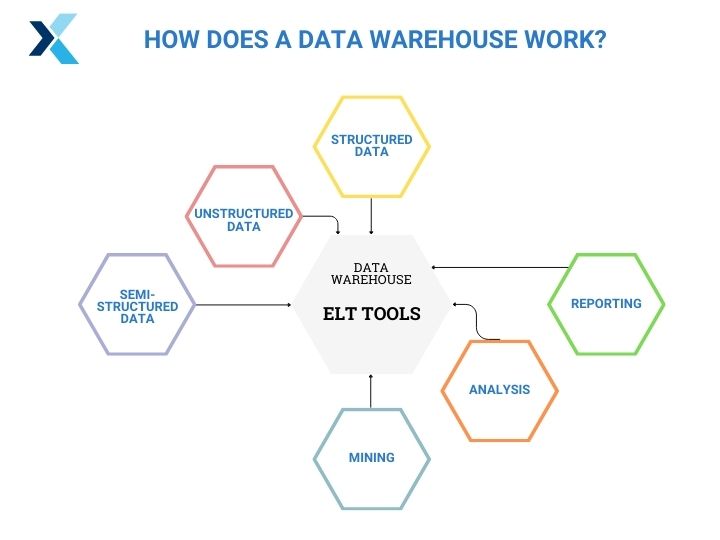
This complexity makes the DWH a dynamic environment where various operations occur to enable effective analysis.
- Data is first gathered from diverse sources and integrated into a central database in the data warehousing process. This consolidation combines customer information from point-of-sale systems, websites, and other sources to gain deeper insights into the customer base.
- Following collection, the data undergoes sorting, processing, and storage. Processed data is organized into tables based on type and format, with attention to data security, including sensitive information like employee details.
- Once stored, data enables insights such as customer behavior patterns and market trends. The data warehouse’s central role facilitates effective data management and organization, supporting informed business decision-making.
As mentioned above, data warehouses work broadly regardless of how you create them. Next, we will discuss a few of the major types of data warehousing techniques that you can develop or work with.
Types of Data Warehouse
The most crucial types of data warehouses currently exist are Enterprise Data Warehouses (EDW), Operational Data Stores (ODS), and Data Marts.
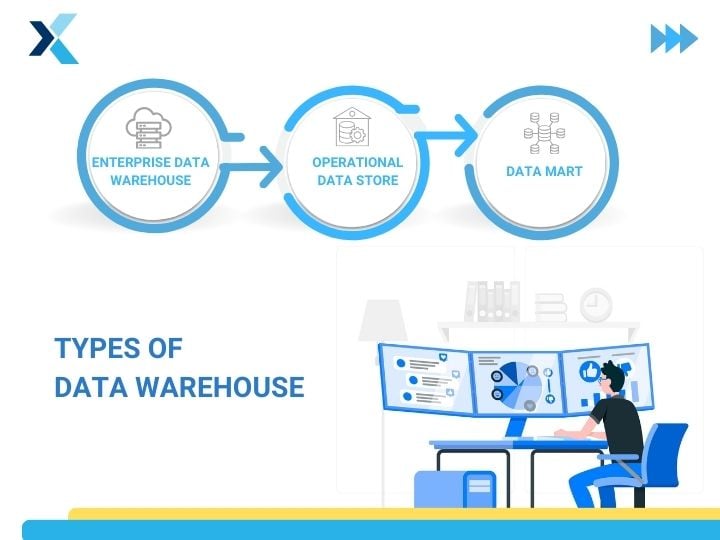
Let’s explore each one.
1) Enterprise Data Warehouse (EDW)
EDW is a centralized warehouse that enables decision support services across the enterprise. It is used when a unified approach for representing and organizing data is needed. A major advantage of EDW is that it classifies data based on subject and provides access to those divisions, enabling better data governance and management.
2) Operational Data Store (ODS)
When data warehouse or OLP systems cannot support an organization’s reporting needs, ODS is used. It is better to use ODS for routine activities (e.g., storing records for employees) as it allows the data warehouse to be refreshed in real time.
3) Data Mart
Of the many types of data warehouses, a data mart is unique. Considered a subset of a data warehouse, a data mart is specially designed for specific business lines such as sales, finance, etc. Many examples exist where independent data marts allow users to collect data directly from the source.
If the major types of data warehouses are clear, then let’s focus on the stages of data warehousing. Data warehouses have evolved through multiple stages, which we will discuss in the next section.
Data Warehousing Stages
Organizations started with relatively simple data warehousing. However, with time, the use of data warehousing became more sophisticated. At each stage in the evolution, data warehouses dealt with the data differently.
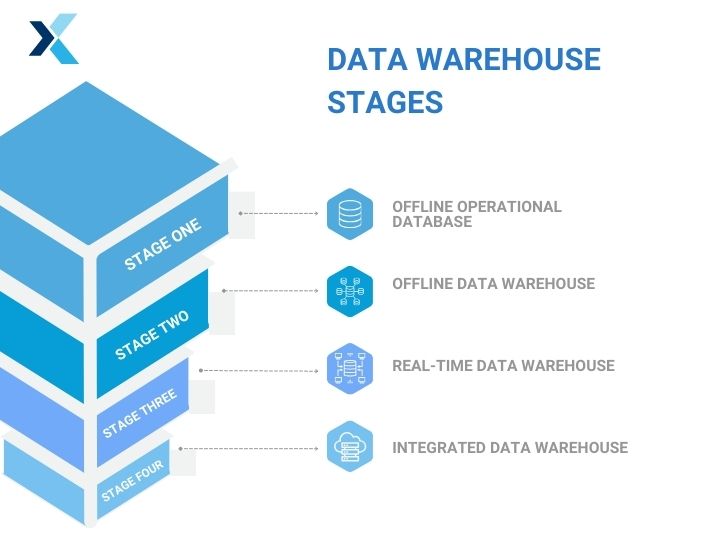
The following are the four major stages of data warehouses that you should be aware of.
-
Offline Operational Database
In the earliest stage of data warehousing, the data was copied from an operation system to a server. This methodology ensured no adverse effect on the operational system’s performance due to the loading, processing, and reporting of the copied data.
-
Offline Data Warehouse
In the second stage, operational databases regularly updated the data warehouses to acquire actionable business insights. During this phase, the data warehouse performed mapping and transformation to fulfill its objectives.
-
Real-time Data Warehouse
In real-time data warehouses, the DWH updates based on events or transactions. Thus, it updates when an operational database records a transaction or event. A railway booking system exemplifies this usage.
-
Integrated Data Warehouse
In the last and final stage of the data warehouse, it updates with every transaction from the operational system. The data warehouse generates transactions that are subsequently passed back to the operational system.
To understand data warehouses better, you need to learn the major components. Let’s explore them.
Component of Data Warehousing
There are a few major data warehousing components that ensure its smooth functioning. A few of the key components are as follows-
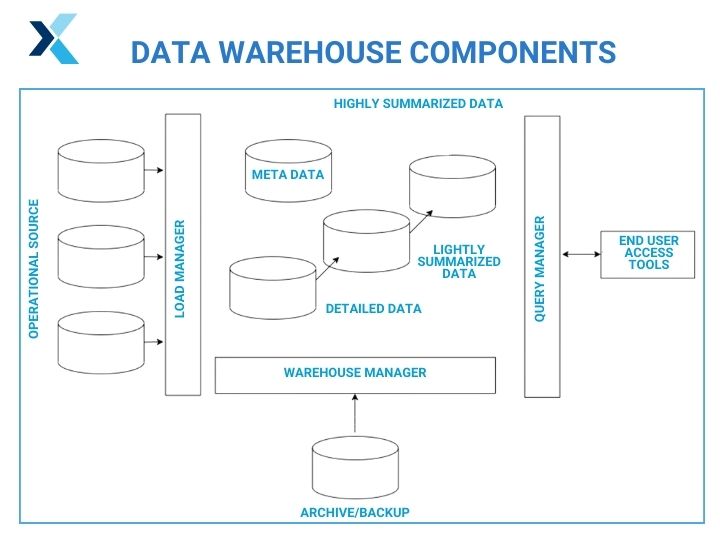
#1. Load Manager
The front-end component of data warehousing is responsible for various operations, such as extracting and loading data into the DWH. This component transforms data to be prepared for storage in the DWH.
#2. Warehouse Manager
The data warehouse manager performs the operations related to data management. The key operations performed by this component include creating indexes and views, merging and transforming source data, analyzing data for consistency, generating denormalization and aggregations, and archiving and backing up data.
#3. Query Manager
The query manager is the backend component of the data warehouse. As the name suggests, the query manager manages the user queries, i.e., it allows users to execute queries by directing them (queries) to the appropriate tables. The complexity of this component is determined by the features provided by the database and the end user access to operational tools.
#4. End User Access Tools
End-user access tools are a major component of the DWH. This component refers to the numerous tools the users employ to interact with the data in the DWH and perform the various tasks involved in data warehousing. The tools are typically categorized into five groups, i.e.,
- Query tools
- Data reporting tools
- OLAP and data mining tools
- EIS tools
- Application development tools
#5. Central Database
The foundational component of a data warehouse is a database. While traditionally, standard relational databases were run on-prem or on-cloud, with the advent of big data, in-memory databases are more commonly used. This shift is due to the need for real-time performance and a reduction in the cost of RAM.
#6. Data Integration
Another component of a data warehouse is data integration as it allows user to pull data from the source system and modify it to align the information for analytical consumption using numerous data integration techniques such as ELT, ETL, bulk loading processing, real-time data replication, data quality and enrichment services, data transformation, etc.
#7. Metadata
Metadata, often described as “data about the data,” is essential in data warehousing as it provides crucial information about the stored data. It serves as a data catalog or dictionary, detailing features such as usage, source, and values.
Metadata can be categorized into technical and business metadata. Technical metadata focuses on data access, structure, and storage location, while business metadata provides contextual information. Metadata holds details about logical structures, records, indexes, and more and plays a vital role in query management, extraction, loading processes, and other operations.
#8. Source Data
Source data is unsurprisingly one of the key components of the data warehouse as it is the data coming into the DWH. Such data can be divided into four categories: production, internal, archived, and external. The data coming from different enterprise operating systems is called production data.
In contrast, data like reports, department databases, private spreadsheets, or customer profiles are called internal data. Then, there are other types of data, such as archived data, which refers to the old data periodically stored in archived files in any operational system. External data, as the name suggests, is data or information sources from external locations, i.e., outside the organization.
#9. Detailed Data
Detailed data complements the data collected and loaded into the data warehouse. It helps as it holds the detailed data in the database schema.
#10. Summarized Data
Summarized data, containing predefined aggregations, is integral to the data warehouse and is generated by the warehouse manager to enhance information efficiency and accessibility.
#11. Backup Data
The summarized and detailed data are stored and relocated to archives such as optical disks or magnetic tapes for backup and archiving.
#12. Data Staging
The data staging component is the next logical component after the source data component. The data must be prepared for storage once extracted from various external sources and operation systems. This component’s primary functions are data extraction, transformation, and loading.
Numerous techniques are employed in data extraction to deal with the various data sources. On the other hand, data transformation deals with cleaning, sorting, aggregation, merging, re-duplication, reshaping, summarization, and data standardization. Lastly, this transformed data performs the loading functions, i.e., moving data into the data warehouse storage.
#13. Data Storage
Data storage is a crucial component of data warehousing. In data warehousing, storage is often a split repository. The data repositories hold only highly structured, normalized current data for operational systems.
#14. Information Delivery
The information delivery component is critical for the process of subscribing files in the data warehouse and transferring them to one or more destinations according to the customer-specified scheduling algorithm.
#15. Management and Control
The management and control component coordinates the functions and services within the data warehouse. It controls data transformation and its transfer into data warehouse storage.
The component also performs several other functions, such as modeling data delivery to clients, working with database management systems, authorizing data for correctly saving in repositories, and monitoring the movement of information into the staging method and then to the warehouse storage.
After learning the basics of Data Warehousing, let’s go into a little more detail by discussing the benefits and challenges of Da
Benefits and Challenges of Data Warehousing
Data warehouses have several pros and cons. If you plan to implement it, knowing about these advantages and disadvantages can enable you to make the right decisions during the implementation.
-
Benefits
There are several benefits of data warehouses, such as
#1 Easy Integration
If integrated properly, data warehouses add value to numerous operational business applications like CRM systems. Data warehouses allow information conversion to a manageable and simple form, allowing department members to understand the presented data.
#2 Fast Data Retrieval
You often forget where you stored data. Using a data warehouse mitigates such issues, as once the data is entered into a data warehouse, it can be easily retrieved without wasting much time.
#3 Increase in Data Analytics Capability
Most business intelligence (BI) and data analytics (BA) tools require highly standardized data to work with them effectively. DWH enables BI and BA operations to be performed speedily and effectively.
Also read: Business Intelligence vs. Business Analytics: What Are The Differences?
#4 Better Data Quality and Consistency
Businesses today create and capture data in numerous formats. Data can be structured, such as financial records, or unstructured, such as social media data. A data warehouse helps maintain the quality and standard of the data generated by various business divisions, which helps in efficient analytical operations.
#5 Improve Bottom Line
Data warehouses allow a business to access its historical data quickly, enabling the leadership to assess past successful and failed initiatives easily. This enables the executives to adjust their strategies to maximize efficiency, decrease costs, increase sales, and maximize their chances of success, thereby improving their bottom line.
-
Challenges
Despite the numerous benefits, there are some major issues with data warehouses, such as
#1 Maintenance Cost
The cost of updating data warehouses is high. Employing the latest technology can be costly if a business wants to keep the most up-to-date features for its DWH. Thus, regular system maintenance costs more than the initial investment to establish the DWH.
#2 Data Preparation
The data must be well-prepared for storage in a data warehouse to simplify data-based operations. Unfortunately, this preparation is highly time-consuming and often has to be done manually.
#3 Unnoticed Flaws
Several issues with the data can remain undiscovered for many years. This is because the source networks supplying the data to the DWH may have hidden issues that may be discovered too late. For example, some fields may accept null when entering new product information, causing the staff to enter imperfect product information even when the relevant information is available.
#4 Issues with Unstructured Data
Data warehouses are typically not an ideal option for storing unstructured data, and often, heavy data transformation needs to be done before data warehouses can be used.
#5 Resource Heavy
Developing and maintaining a DWH is generally a big IT project. Typically several resources of an organization get sucked up by data warehouses leading to a resource crunch in other areas of business. Therefore, the efforts and expenses involved in developing and maintaining data warehouses must be justified.
Now that you know the benefits and challenges of data warehouses, we will learn how to implement data warehousing for your organization.
How to Implement Data Warehousing?
Most companies today try to have a DWH, which saves data from multiple sources in a centralized repository. As the data is available in one place, businesses can easily report, analyze, and discover meaningful insights at completely different combination levels.
To successfully implement a DWH, you must remember that several activities are often performed to gather and deliver data to businesses.
The following are the most crucial steps you need to perform to implement a DWH.
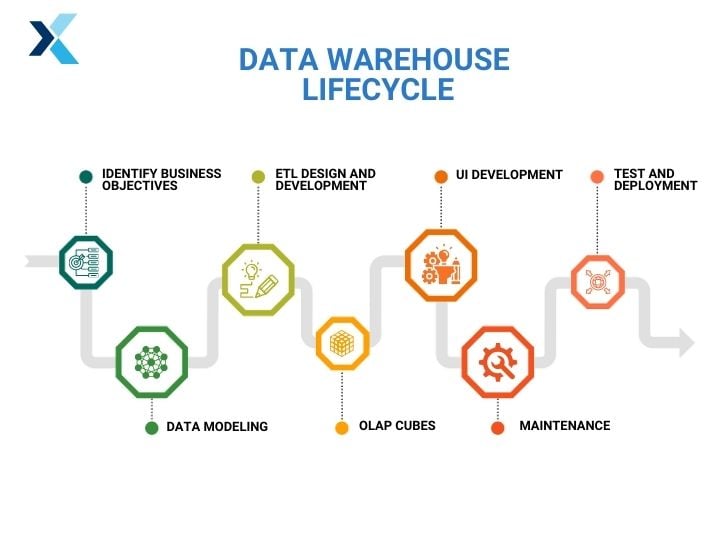
-
Identify Business Objectives
The first step in implementing a DWH is identifying the business’s objectives. Business analysts prepare a business requirement specification document. Collecting all the requirements from numerous clients and various stakeholders takes months.
The data modeler recognizes the dimensions, facts, and combinations based on the gathered requirements. This serves as the blueprint of the DWH, as the business needs are determined and placed in the DWH at this stage.
-
Data Modeling
The next step in developing a DWH is data modeling. Here, the data distribution is visualized, and the database is designed. The data is transformed into a format that can be stored in the DWH. Data modeling is as crucial in building a DWH as a house blueprint is in constructing a house.
Based on the data model, the data is organized, connections between datasets are created, and data compliance and security are established, aligning with the DWH’s goals. Data modeling is the most complex phase of the data warehouse implementation, as this process starts at the data mart level and gradually branches out into a DWH.
The data model developer also needs to assess various schemas, which is the logic of how data gets stored in a data warehouse concerning other data. The common schema used for creating data models are star schema, snowflake schema, and galaxy schema.
-
ETL Design and Development
In the third stage, ETL (Extract, Transform, and Load) tools are used, which allows data extraction from multiple sources, such as data lakes. The ETL process enables data transformation, fulfilling the data format requirements and loading data in the DWH for downstream activities like reporting.
ETL tools like IBM Information Server, SAS Data Management, and Hive are indispensable for enhancing data pipeline visualization, speed, and consistency between the new data warehouse and the existing architecture. They ensure efficient ETL operations and rapidly develop a valuable data warehouse across all organization levels.
Also read: What is a Data Pipeline? Types, Benefits, Best Practices and More
-
OLAP Cubes
Once data is transformed, it may consist of unrelated but significant key performance indicators for different business aspects. To track various business processes effectively, it’s crucial to identify the entities collaborating to generate these indicators. This necessitates a data structure for swift analysis across multiple dimensions.
This is where an OLAP cube, also known as a hypercube or multidimensional cube, becomes essential. Typically, a data warehouse extracts information from diverse sources in various formats (such as Excel sheets, multimedia, text files, etc.), cleanses and standardizes it, and loads it into an OLAP cube (or OLAP server) for further analysis.
Unlike two-dimensional data, which can be organized in rows and columns in a spreadsheet, data in a DWH originates from multiple sources in different formats. An OLAP cube facilitates the structured and logical storage of such multidimensional data.
-
Development of UI
Up until this point, backend development has been the focus. The user interface is now constructed, enabling user interaction with the computer system. Users utilize input software to engage with the data warehouse, employing various UI development, BI, and data analytics tools.
-
Maintenance
Tracking any changes made to the DWH schema, application domain, or requirements is important. Therefore, implementing data warehouse maintenance systems becomes imperative to monitor any system modifications or changes, including alterations in dimensions, data categories, and the insertion or deletion of user-defined attributes. The subsequent section will delve into the maintenance practices for data warehouses.
-
Test and Deployment
The last step in developing and implementing a DWH is thoroughly testing it to ensure that the developed DWH is achieving the business objectives. Several actions are performed as part of the testing, such as data completeness, data integrity, data transformation, effective usage of ETL tools, etc.
After completing testing, deploy the developed DWH to ensure users can access it and perform expected analyses. The DWH might deploy in the organization’s cloud system. Once all functions are implemented and confirmed operational, the data warehouse implementation will be successful.
The above steps can be followed to build any type of data warehouse. Examples of data warehouses built using the above steps can be found in many industries, such as insurance, finance, healthcare, etc.
Once the DWH is developed and deployed, it must be managed, which we will learn in the next section.
How to Maintain a Data Warehouse?
After setting up a data warehouse, you must continuously maintain it to ensure accurate insights from the data. Improper maintenance can lead to depreciation over time, resulting in erroneous queries and conflicting outputs. As a data warehouse ages and lacks proper maintenance, various issues arise, including obsolete metrics, unoptimized modeling, and accumulation of permission and access issues.
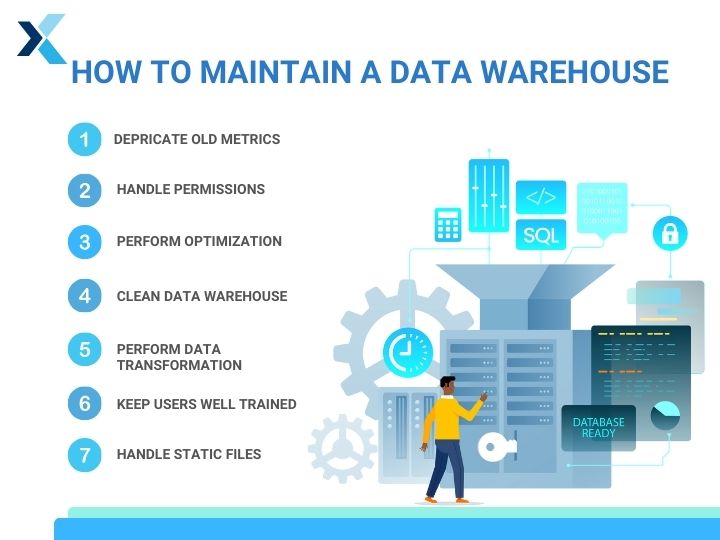
You should follow the steps below to ensure the DWH remains up to date.
1. Deprecate Old Metrics
As data evolves, reproduces, and becomes obsolete, organizations should remove outdated data that no longer holds analytical value. To signify disuse, append “_deprecated” to objects such as columns, tables, and views.
2. Handle Permissions
As employees leave, join, and change roles, updating their access permissions to the DWH becomes an ongoing necessity.
3. Perform Optimization
The original DWH structure must adapt to new data, business objectives, and techniques through reconfiguration to optimize performance and utilization.
4. Clean Data Warehouse
Regularly cleaning summary data and weblogs is crucial to prevent performance issues caused by congested logs. Additionally, backing up this data helps maintain historical records whenever feasible.
5. Perform Data Transformation
Data in the DWH can be consolidated or disaggregated to enhance analysis, such as grouping by day, month, or year for transaction data. Mapping related data into a unified format also improves manageability and effectiveness.
6. Keep Users Well Trained
Users should undergo training on querying data efficiently, managing contingencies, and accessing database structures as new technologies are implemented in the DWH.
7. Handle Static Files
The static files must be updated if you load new data and rebuild an index. This helps optimize query transactions, enhancing the overall performance speed of the DWH.
Once involved in developing, maintaining, or using the data warehouse, you need to use numerous tools. Next, we will discuss a few of the key data warehousing tools.
Various Data Warehousing Tools
The dynamic field of data warehousing utilizes various tools. Some extract and transform data, while others handle loading, modeling (defining data relations), querying, reporting, and analysis.
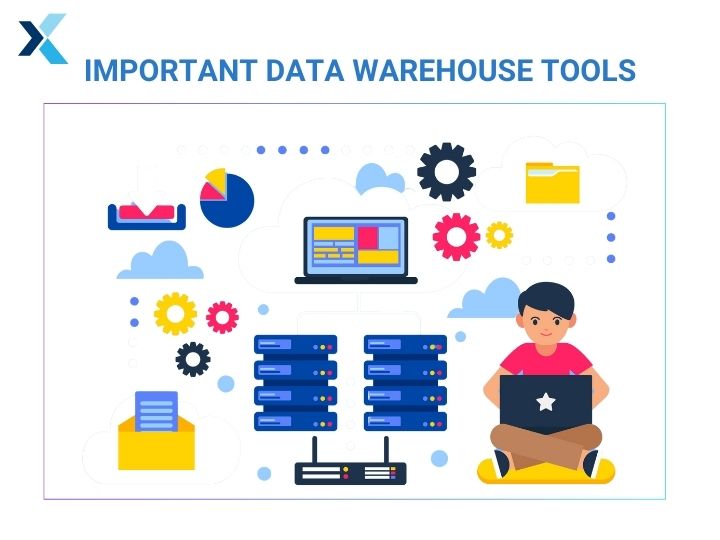
You must explore the following tools to perform the various activities required for data warehouse work.
- Amazon DynamoDB
- Amazon RDS
- Amazon Redshift
- Amazon S3
- BI360 Data Warehouse
- Cloudera
- CloverDX
- Exadata
- Google BigQuery
- Hevo Data
- IBM Db2 Warehouse
- MariaDB
- MarkLogic
- Micro Focus Vertica
- Microsoft Azure
- Oracle Exadata
- Panoply
- PostgreSQL
- PowerBI
- SAP Datawarehouse Cloud
- SAP HANA
- Snowflake
- Tableau
- Teradata
You must know that data warehousing is fast evolving and keeps up with the latest and expected changes in this domain. Let’s discuss what you can expect in the future of data warehousing.
Future of Data Warehousing
While it is always difficult to ascertain the future, a few emerging trends can give us some idea about the future of data warehouses.

These are as follows-
- Artificial Intelligence (AI) will play a crucial role in data warehousing. It will extensively use natural language processing, machine learning, and other advanced data science techniques to enable users to analyze complex data more efficiently and intelligently.
- Cloud-based data warehouses are becoming increasingly popular. Their advantages include quick deployment, low ownership costs, dynamic scalability, enhanced security, robust disaster recovery mechanisms, rapid processing of real-time data, and seamless integration with emerging technologies.
- Upcoming regulatory constraints will limit organizations’ ability to combine data from disparate sources.
- The availability of multimedia data (which will be unstructured) will be on the rise, making their storage in data warehouses an area of research.
- Automation technology may get involved in the strategy, design, integration, and maintenance steps of the data warehouse lifecycle.
- Data lakes hold unstructured data, and data warehouses hold structured data, and these two technologies might converge in the future.
- Features like Snowflake’s zero-copy cloning will see wider adoption. Zero-copy data sharing will help reduce the cost, risks, and other issues associated with traditional data-sharing methods.
- Zero-ETL integration may see widespread support, allowing users to move data between two platforms without performing ETL first.
Before concluding this discussion on data warehouses, we must address the common confusion many individuals have when learning about them: the difference between a DWH and a database.
Data Warehouse vs. Database: Major Differences
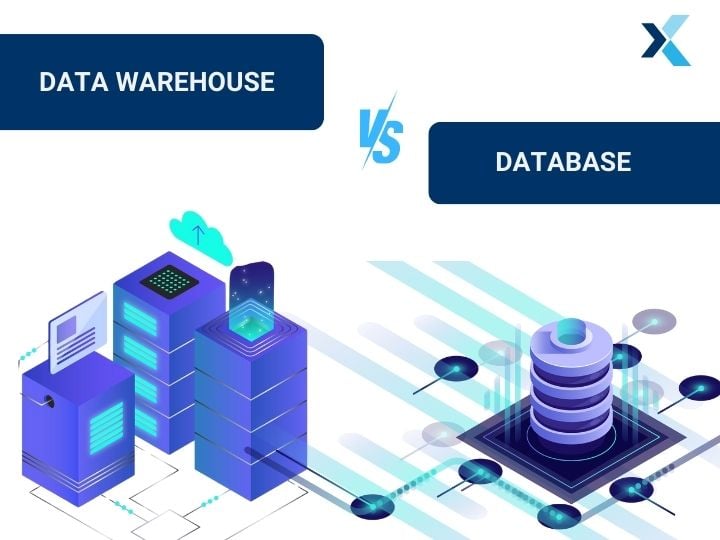
The confusion between a database and a data warehouse is common, but they have distinct characteristics. While both structures facilitate storing data for analysis, they differ significantly.
A key distinction is that data warehouses are subject-oriented, focusing on specific data types like sales or transactions. In contrast, databases can accommodate multiple data types and often serve as a source for data warehouses, making data warehousing akin to a “database of databases”.
Also, databases record real-time transactions, continuously updating entries as events occur and prioritizing high-speed data entry. In contrast, data warehouses analyze data from various sources and prioritize fast querying of large datasets once they are recorded and loaded.
Conclusion
The increased volume of data organizations produce today has caused them to focus on data warehouses. This is evident from the fact that the market value of the data warehousing tools moved from $27.93 billion in 2022 to $31.85 billion in 2023.
Data warehouses provide a great solution for managing today’s large volumes and variety of data. Organizations today expect you to know about the various aspects of data warehouses, such as their types, components, and development stages, as discussed in this article.
However, you must also explore the numerous architectures and schema of data warehouses. Common architectures of data warehouses include host-based, LAN-based, single-stage, multi-stage, stationary data, distributed, and virtual data warehouses. Star, Snowflake, and Galaxy are common data warehouse schemas you should explore.
FAQs
-
What is a data warehouse, for example?
Data warehousing is the process of collecting data and information from multiple sources into one comprehensive database. In the healthcare industry, a data warehouse generates treatment reports shared with research labs, insurance providers, and medical units, facilitating informed decision-making and improving patient care.
-
What is a data warehouse, and what are its types?
The three most common types of data warehouses are Enterprise Data Warehouses (EDWs), Operational Data Stores (ODSs), and Data Marts.
-
What is the need for a data warehouse?
The database allows for storing high volumes of data and helps organize and understand historical data. Users can make strategic decisions by storing data in a central repertory by analyzing trends.
We hope this article helped you better understand the implementation, maintenance, and usage of data warehouses. Contact us if you want to learn more about data warehousing or the tools involved.

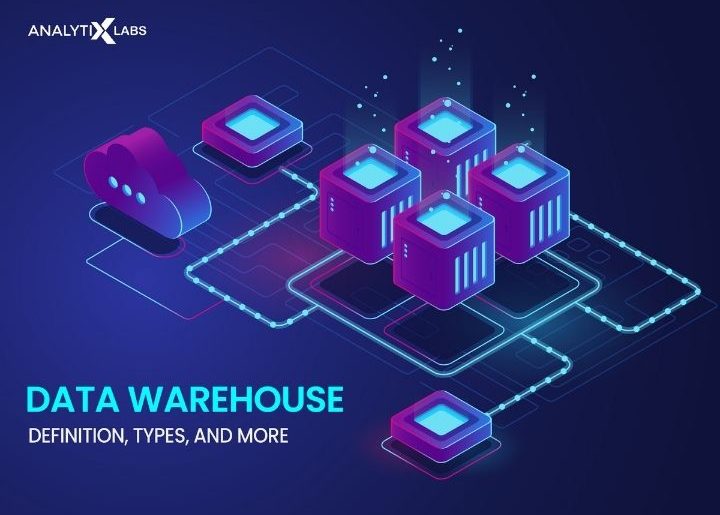



![Tree Traversal in Data Structure Using Python [with Codes] tree traversal in data structure](https://www.analytixlabs.co.in/blog/wp-content/uploads/2025/01/Cover-Image-1-370x245.jpg)


